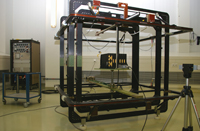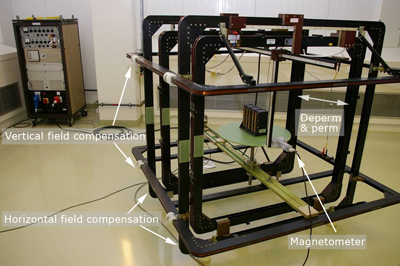Magnetic Coil Facility at ESTEC
Most frequently, the spacecraft that require 'magnetic cleanliness' are those that will be making magnetic field measurements as part of their mission, for example, Cluster. The LISA Pathfinder mission has stringent requirements regarding the magnetic characteristics of the spacecraft and requires magnetic cleanliness to prevent spurious magnetic forces affecting the two test masses that form the heart of the mission.
History
Back in 1980, it was decided to build five small magnetic measurement systems, essentially identical, in order to test and characterise equipment units before integration on spacecraft requiring magnetic cleanliness.
 |
|
The Ulysses Magnetic Coil Facility at ESTEC, the Netherlands, with a LISA Pathfinder payload element during testing in 2009. Credit: ESA |
The other three MCF units of the original five are in use at various locations across Europe. There is one in EADS Astrium Friedrichshafen, in Germany, that belongs to Imperial College London and that is being used for Swarm. Another is at the Technical University of Braunschweig, in Germany, and the final unit is at the Space Research Institute of the Austrian Academy of Sciences, in Graz.
Design
The MCFs are miniature versions of the large magnetic facilities such as those found at CNES in Toulouse, France, and IABG in Ottobrunn, Germany.
 |
|
The Ulysses Magnetic Coil Facility at ESTEC, the Netherlands, with annotations. Credit: ESA |
The MCFs allow:
- compensation of the Earth's magnetic field, using two pairs of Helmholtz coils
- demagnetisation (also known as deperming) of equipment units
- testing the susceptibility of equipment units to magnetisation (also know as perming)
- automatic acquisition of the magnetic field from equipment units while rotating them through 360° and computation of equivalent Multiple Dipole Models of them (by solving the associated inverse problem through non-linear optimisation)
The facility was refurbished in 2005-2006, and the software upgraded at that time to include automatic test report generation.
The Ulysses MCF originally used a single three-axis fluxgate magnetometer with a sensor head designed by NASA's Goddard Space Flight Center, similar to the ones flown on the Giotto and Cluster missions. The initial design seems to date from Voyager I and II. It was later replaced by two smaller, state-of the-art commercial fluxgate magnetometers.
In addition to the LISA Pathfinder test campaign of 2009 the MCFs have also been used for the following space missions:
- Giotto (Launched in 1985)
- Ulysses (Launched in 1990)
- Cluster (Launched in 1996), Cluster II (Launched in 2000)
- Cassini-Huygens (Launched in 1997)
- Rosetta (Launched in 2004)
For further details about the Magnetic Coil Facility at ESTEC please contact:
Laurent Trougnou
Technical and Quality Management Directorate, ESA
Email: Laurent.Trougnou esa.int
esa.int
Axel Junge
Technical and Quality Management Directorate, ESA
Email: Axel.Junge esa.int
esa.int

